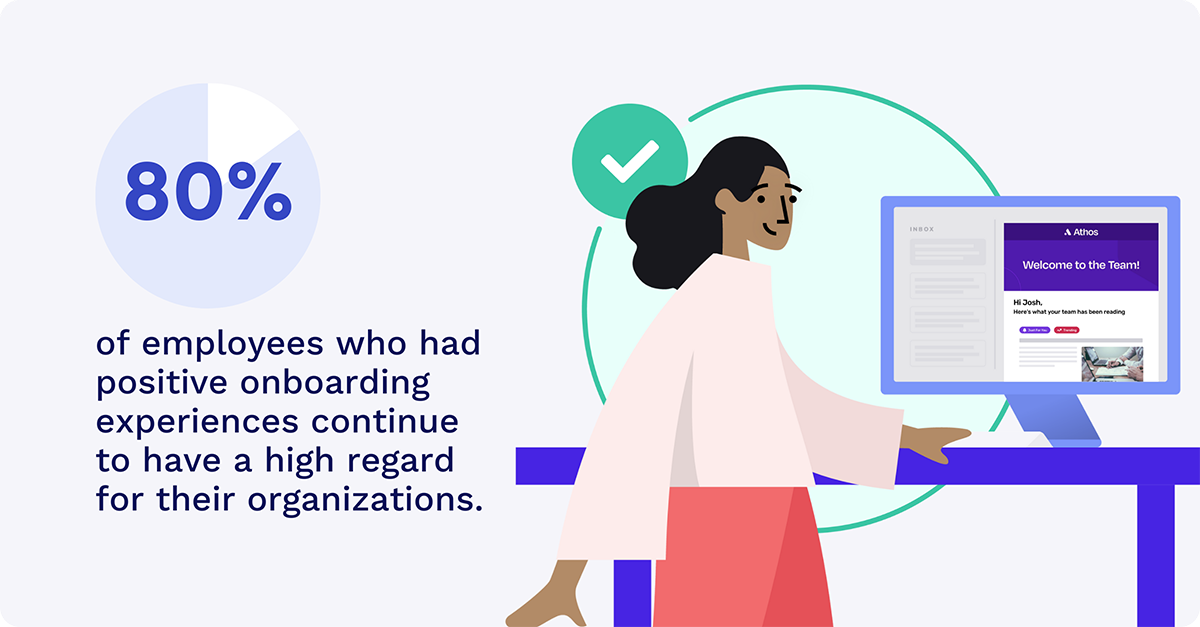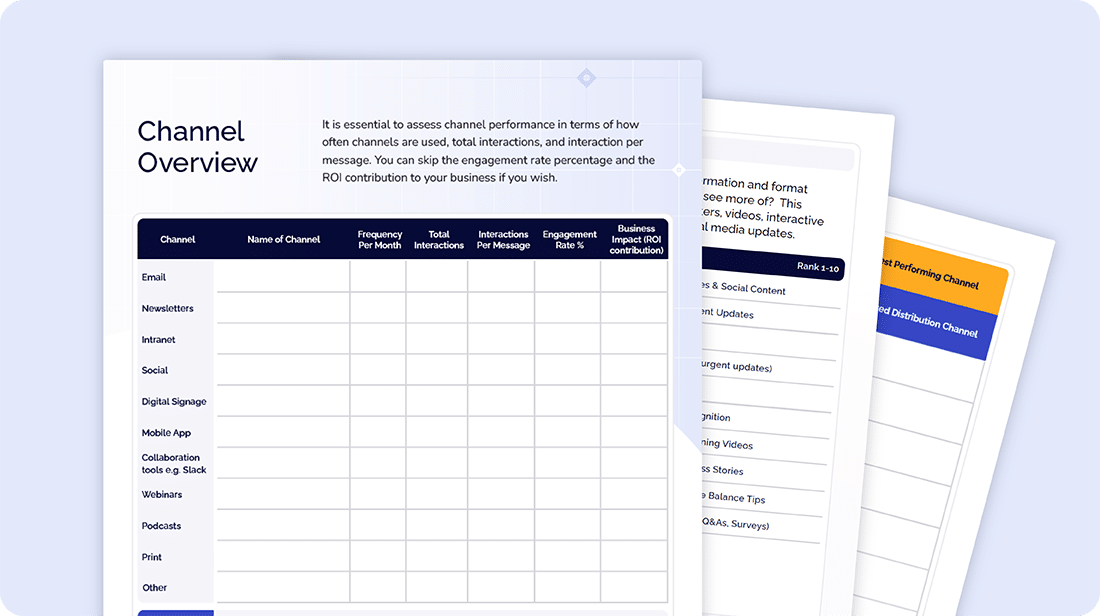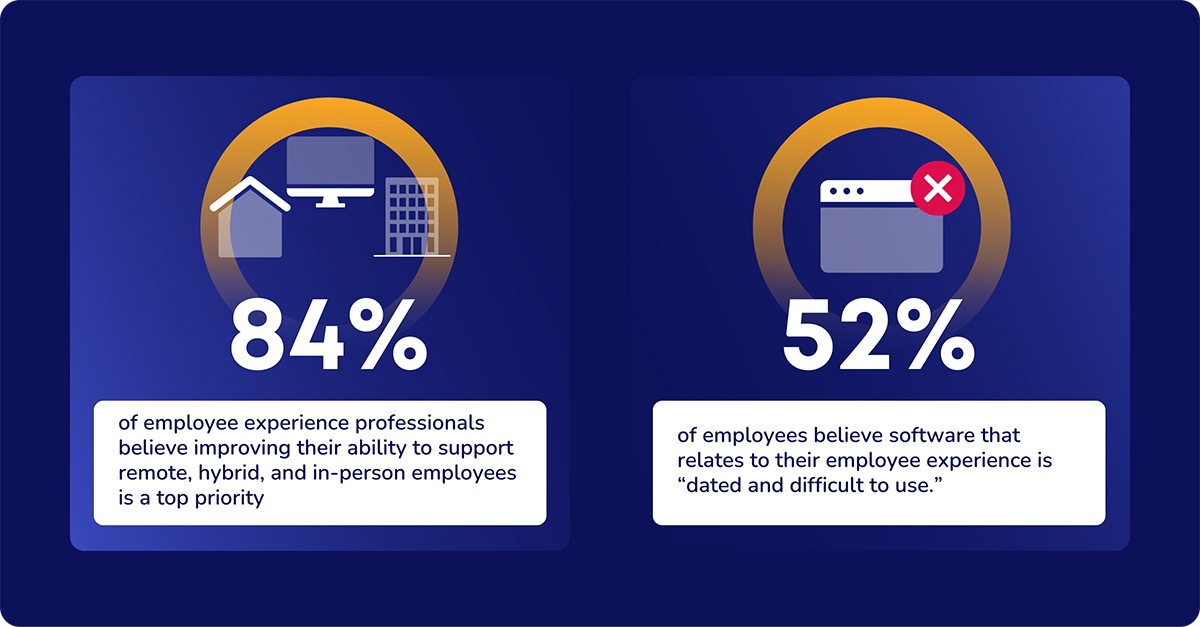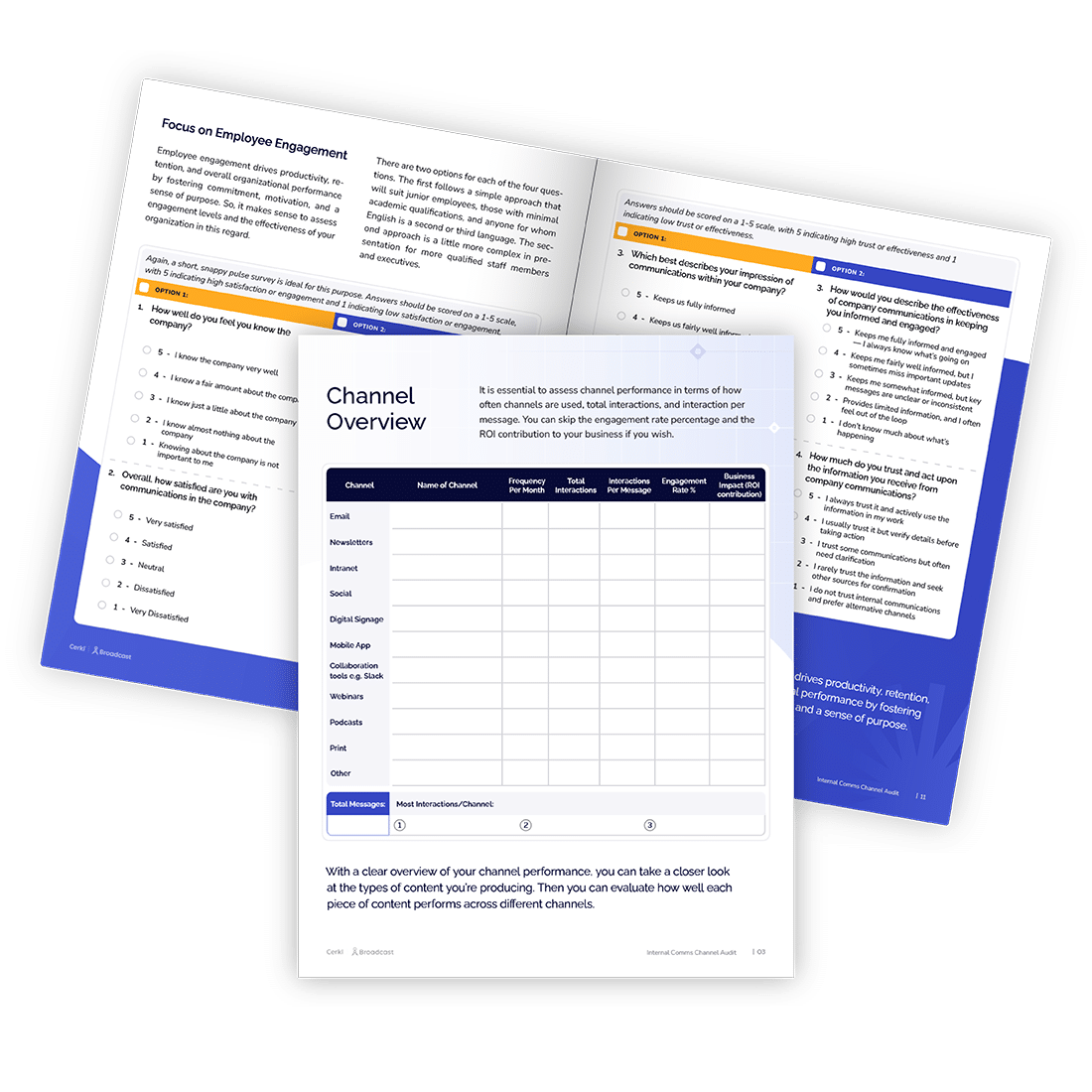Maximize EX by introducing as many employee experience best practices as you can. Learn about innovative techniques to create an immersive EX.

.png)
Strategy is an important component of internal communications. Ensure you’re communicating through the right channels at the right frequency with our Internal Communications Channel Audit worksheet.
Access NowAn organization thrives when its employees are satisfied and engaged. That's why understanding and implementing a robust employee experience (EX) strategy is key to achieving overall success.
According to the Qualtrics 2023 Employee Experience Trends report, all employees crave more human experiences. It points out that nowadays, being employed isn’t just having a job you get paid to do. It’s “a part of a person’s value system.” Increasingly, employees want to work for organizations that have purpose and integrity. But they also want development and growth opportunities that motivate, challenge, and fulfill them.

Qualtrics research shows that when organizations embody these values, 27% of workers are more likely to have higher employee engagement scores. They are also 23% more likely to stay with the organization for at least three years.
Their research also found that employee experience is critical. Employees want job security and financial certainty. They want the reassurance that the organization they work for will continue to be successful and pay a competitive salary. But only 57% stated they were satisfied with their current benefits and pay.
When processes are inferior and systems inefficient, the risk of employee burnout increases. Qualtrics research found that 38% were experiencing burnout symptoms, which disrupt productivity.
In this article, we’re going to explore the intricacies of employee experience, its significance, and the best practices to enhance it.
We will introduce you to innovative techniques including immersive onboarding, AI-powered personalized learning paths, and virtual reality team-building initiatives. When an organization focuses on creating a positive and immersive employee experience this can propel your workforce to greater heights.
The term employee experience, often referred to as EX, represents an evolving concept in the human resource (HR) world. It refers to the entirety of interactions, perceptions, and feelings that an employee has with their workplace, from recruitment to onboarding, routine work, and eventual exit.
In short, EX covers every aspect of an employee's journey and interaction with a company. Think of it as a combination of the company's culture, the physical workspace, and the technology that enables employees to perform their duties. Consequently, employee experience plays a crucial role in not only attracting but retaining talent as well.
BambooHR surveyed employees about their onboarding experiences and found that 80% of employees who had positive onboarding experiences continue to have a high regard for their organizations. They are also more committed to their employer. Of course, this is the start of the employee experience, and a very important one.

It’s important to realize that onboarding isn’t a quick process. It can last for months or even up to a year, all the while adding to the employee experience. Ultimately, the aim is to ensure that newly hired employees feel welcome and know that they will have ongoing support.
At the same time, it's important to remember that employee experience isn’t merely about throwing perks into an office environment. It goes far beyond that, aiming to cultivate a supportive work environment that promotes employee engagement, satisfaction, and overall well-being. Various elements like effective communication, transparent operating procedures, and opportunities for employee growth can all influence an individual’s perception of EX.
Upgrade your company’s internal comms to enhance employee communication

Every business leader understands that a company's biggest asset is its team members. There is a common saying in business, "Satisfied employees make happy customers”. But it doesn’t end there, as Shep Hyken points out in a Forbes article. A customer service and customer experience expert, Hyken notes that happy customers make happier employees!
“It’s more than just hiring and training the right people, although that’s a big part of it. It’s also investing in the right solutions that give both customers and agents the best experience.”
Shep Hyken
The initial saying underscores the crux of employee engagement. It highlights how having satisfied employees can lead to increased customer satisfaction and eventually drive overall business success. Creating a positive employee experience helps to make employees feel valued, appreciated, and part of the organization's growth story.
The journey to fostering a supportive work environment starts with recognizing the importance of a great employee experience. In most cases, this involves formulating and implementing employee experience management strategies. It is vital to realize that employee experience isn’t just about the benefits you provide to your employees. Instead, it involves creating an environment where employees feel empowered, motivated, and satisfied with their work roles. It's about building an exceptional employee experience that motivates employees to contribute their best to the organization.
Here are a few reasons why it’s essential to create a satisfying working environment for employees.
Employees are more productive when they are happy and satisfied with their work and the workplace. When an adequate support system is in place employees are more likely to take on challenges and go the extra mile to meet organizational goals.
A positive workplace culture and good employee experience generally result in lower turnover rates. When employees are satisfied with their jobs, they tend to remain loyal to the organization. This can drastically reduce the costs associated with employee turnover and recruitment.
Satisfied employees are more engaged in their roles and are more likely to contribute ideas and innovations to the organization. When employees are engaged, they are more committed to their work and demonstrate greater resilience, even in the face of adversity.
Satisfied employees project a positive image of your company, which in turn helps to attract top talent.
Ultimately, maintaining a genuinely satisfied workforce needs strategic talent management and a close study of what drives the employee lifecycle. This should go hand-in-hand with continuous listening to their needs, habits, and preferences. They can tell you a lot about their job satisfaction and engagement levels through their behavior, performance reviews, and employee feedback.

Here’s a list of the employee experience best practices to get you started:
Upgrade your company’s internal comms to enhance employee communication

Now that we’ve mentioned some of the best employee experience practices to look for, let’s explore ways of implementing them to increase and improve employee satisfaction and engagement.
The journey to creating a great employee experience starts with understanding and implementing a variety of employee experience best practices. These practices aim to foster an engaging, supportive work environment that promotes a positive employee experience and contributes to your team's success.
First impressions count. An immersive onboarding experience can set the tone for a new employee's journey. Instead of a traditional PowerPoint presentation, think about using immersive technologies like augmented reality (AR) or virtual reality (VR) for an experiential dive into the company culture. Colleague introductions, facility tours, even live projects can be a part of this experience, kickstarting a great employee experience right from day one.
Twitter’s long-established Yes to Desk employee onboarding program is an inspirational approach. The key aim, when the program was introduced, was to ensure a seamless transition into the company from the moment an employee accepted a job (said “yes) to getting to their desk. A case study, undertaken by the IBS Center for Management Research in 2022 before Elon Musk bought and rebranded Twitter (now X), highlights features of the program. It also shows how the company continued to improve the program and other hiring principles, especially during the COVID 19 pandemic. It is not known whether Musk has retained the Yes to Desk program.
One of the crucial elements of employee engagement is professional growth. AI-powered personalized learning paths can help employees identify areas of skill enhancement, and provide customized learning resources. They can analyze individual performance reviews, engagement surveys, and personal interests to create a unique learning experience.
Leadership classes, project management tutorials, or even a reading list from your reading lists can be offered. What's important is creating development opportunities aligned with each employee's career path and personal growth objectives.
Since they are powered by AI, it stands to reason that the potential of these learning paths continues to grow exponentially.
Team-building activities are critical for building rapport among team members, especially for remote workers. Consider employing virtual reality technology to create immersive team-building adventures. This digital approach is not just exciting. It also allows all employees to participate regardless of location.
A good example is virtual escape room challenges that promote problem-solving and teamwork in a fun, unique way. Teams work together to figure out clues, fostering collaboration and communication in an innovative, quick-paced environment. It is a sure way to promote employee engagement and improve employee experience.
Recognizing and rewarding employees in real-time is an excellent way to keep staff engaged, motivated, and satisfied, contributing to an exceptional employee experience. Performance recognition doesn't have to wait for yearly performance reviews. It’s easy and effective to use digital platforms to provide real-time employee feedback and recognize achievements.
For instance, some companies use social platforms to provide badges for different achievements, while others use monetary rewards or extra vacation days. The key is to create a culture where employees feel valued and appreciated in real-time, helping to boost morale and productivity.
A flexible working environment is no longer a perk for employees. It has become a necessity in today's shifting world and is essential for an effective employee experience strategy. Embracing a hybrid work model is the perfect path to flexibility. It ensures that employees can balance their professional and personal lives, promoting satisfaction, and reducing burnout.
Zendesk’s Employee Experience Trends 2023 indicates that 84% of EX professionals think that improving their ability to support remote, hybrid, and in-person employees is a top priority for their business. But technology in the workplace continues to be a pain point for employees. Zendesk’s survey found that 52% of employees believe software that relates to their employee experience is “dated and difficult to use.”

A key point that the Zendesk trends report highlights is that AI provides an excellent opportunity to control costs and increase efficiency. Unsurprisingly, they found that 68% of EX professionals believe that AI will drive large cost savings over the next few years.
Realizing that flexible working is a priority for many employees and businesses, Lucy Buchholz did some digging for Sustainability online magazine and came up with the top 10 companies leading the way. The Top 10: Global Companies Advocating Flexible Working, she declares, are (from 1-10): Intuit Inc., Google, Apple, Dell, Delta Airlines, Cisco, Microsoft, Booz Allen Hamilton, Northrop Grumman, and Nike. There are lots of companies in technology, but there’s a decent mix of industry niches.
It’s not surprising, since this approach generally results in higher engagement and satisfaction levels among staff. It not only respects employee preferences but also empowers them, signaling trust in their professionalism and commitment.
Mental health is an integral part of the employee experience, and one that should never be ignored. Proactive initiatives, such as mindfulness breaks and wellness programs, can boost employee morale and productivity.
Meditation sessions, online fitness classes, mental health awareness programs, and even pet therapy can be included. Focusing on physical and mental employee well-being sends a clear message that the company cares for its people, contributing to a strong sense of belonging and commitment.
Gamification is a powerful tool for boosting employee engagement and improving learning experiences. By applying game-design elements in non-gaming contexts like professional development, companies can make learning exciting and interactive.
For instance, Duolingo, the language-learning platform, uses a reward system to motivate users to complete lessons and reach new levels. Similarly, businesses can use points and rewards, leaderboards, and levels to motivate employees to engage in professional development activities.
According to the Gamification Global Market Report 2023, the global gamification market grew from $14.87 billion in 2022 to $18.63 billion in 2023. Of course, this doesn’t reflect the use of gamification for professional development, but it does show how enormously popular gamification is. Nevertheless, there’s absolutely no doubt that there are lots of benefits for businesses.
Nicole Fallon, writing for Business News Daily, tells how to gamify your workforce and make employee engagement fun. She suggests adding gamification to employee onboarding and using it for remote workers. The aim is to reduce employee turnover and improve employee engagement. No doubt it’s also an excellent employee experience strategy. Apart from appealing to younger employees, gamification can make learning new things engaging and fun. It also helps to decrease stress.
Creating platforms for employees to share their ideas contributes to a culture of innovation and empowers employees. Innovation hubs, where employees can submit, upvote and comment on ideas, are a great way to make this happen. This type of initiative helps tap into the creative capacity of employees and builds a culture of shared ownership and innovation.
Launched in 2013, Adobe’s Kickbox is a great innovation that has had loads of publicity over the years. The creator, Mark Randall, vice president of Creativity at Adobe wanted to tap into potential innovators at Adobe and empower them.
“We wanted to figure out how to unleash more innovation, beyond relying on a few big-budget projects from engineering and design teams. You need those too, of course, and we have them, but Kickbox is a way to get a lot of ideas, including some you’d never find any other way.”
Mark Randall
He presented it in the red, now legendary Kickbox filled with goodies that they could use to initiate innovative ideas. A Harvard Business Review article revealed what was Inside Adobe’s Innovation Kit including a pen, paper and a bar of chocolate — plus a prepaid credit card for $1,000 each employee was free to use. The result, according to innov8rs, was incredible. Within a year, innovation project ideas at Adobe went from a couple of dozen to about 1,200. While many Kickbox ideas fail, it’s an amazing feature that many companies have now implemented since Kickbox is now an open-source program.
Today, Adobe continues to promote its red box: Unleashing innovation. A six-step innovation process that comes packaged in a bright red box, Adobe Kickbox helps individual employees develop ideas for new products and services. When word got around, Adobe open-sourced Kickbox for any company to use.
AR office tours can help remote workers feel a part of the company culture despite distance. Incorporating an engaging tour of your office space — showcasing amenities, meeting rooms, lounge areas, or even desk spaces — contributes to building a familiar and inclusive experience for remote staff.
Of course, you can also use AR office tours during recruitment to let prospective employees take a virtual tour of your office while learning about the organization’s culture and environment.
Investing in your employees' future with the organization is a meaningful way to engage them. Automated career progression planning can help by providing a clear pathway for growth and progress at the organization.
By planning their career progression, employees can visualize their future with the company via clear benchmarks and new roles up for grabs. This is a great way to increase contentment and commitment.
Creating an inclusive and diverse work environment is a hallmark of successful companies. Establishing a dedicated command center for diversity, equity, and inclusion can help in setting measurable goals, tracking progress, and communicating achievements towards these aims.
A command center could house resources and guidelines regarding personnel policies, programs like unconscious bias training, and initiatives aimed at promoting inclusivity. This kind of setup will demonstrate your firm's commitment towards creating an equal and safe working environment. It will also reinforce your brand's social responsibility.
Technology can also assist in making the workplace more convenient and user-friendly. Consider deploying voice-activated assistants to manage simple tasks such as scheduling meetings, setting reminders, or providing information on company policies.
Not only does this innovative use of technology add a wow factor, but it also simplifies day-to-day tasks, freeing up employees to focus on more strategic initiatives. This kind of use of technology supports a positive, high-tech perception of the workplace, contributing to employee satisfaction and loyalty.
Understanding and continually improving the employee experience is paramount for companies seeking to foster a supportive work environment and drive high engagement levels. Active measurement and enhancement of the employee experience encompass various facets, such as soliciting employee feedback, conducting performance reviews, and offering development opportunities.
At the heart of any strategy designed to measure and enhance the employee experience, there should be a clear acknowledgment that a great employee experience doesn't just happen. To be successful, it needs to be meticulously crafted through a combination of intentional efforts and smart decision-making.
To maximize the efficiency, harmony, and productivity of an organization, it's essential to implement a strategic system that will garner positive employee experiences. This endeavor is achieved primarily by enforcing the most effective proactive tactics regarding employee experience.
One of the most important strategies focuses on continuous listening as a way to improve the employee experience. This is often accomplished through frequent engagement surveys. By inviting employee feedback, and ensuring your teams are heard, you give them a sense of importance, making them feel more connected to the organization.
Surveying team members regularly allows managers to have insight into the employee experience, and promptly act on feedback. Engagement surveys can cover areas like job satisfaction, personal development opportunities, and company culture. Timely resolution of arising concerns can contribute greatly to a positive employee experience.
Attentive performance reviews, if done honestly and constructively, can contribute to a positive and productive work environment. A well-conducted review will make employees feel valued, improving their experience and overall engagement levels.
A supportive work environment requires open and transparent communication. This can take the form of team meetings, suggestion boxes, or regular one-to-ones with managers. Effective and free-flowing communication supercharges employee engagement and satisfaction.
Cerkl Broadcast is a multifaceted platform that encompasses all the essential features you need for effective internal communications and an excellent employee experience. It incorporates everything from audience segmentation and survey strategies to employee feedback mechanisms. It also offers exceptional analytics tools. Facilitating the gathering of insights, we aim to enhance your EX effortlessly. With our guidance, you can explore how to use our employee experience equation/formula to modernize your approach.
Witness the transformative impact of our audience management platform, seamlessly delivering personalized emails and intranet content to engage and enlighten your workforce. Join the ranks of millions of satisfied professionals who rely on Broadcast to streamline their companies' communication processes and elevate overall employee engagement.
We recommend initiating the process with an internal communication audit. This is a crucial step towards enhancing all facets of your internal communications.
The next step is to audit your communication channels to assess their status and determine key metrics.

Upgrade your company’s internal comms to enhance employee communication
How do you create quality employee experience? Creating quality employee experience involves fostering a positive work environment, providing growth opportunities, and ensuring effective communication to enhance job satisfaction and productivity. It’s important to encourage employee feedback to make sure that your employee experience strategy is working.
What is the ideal employee experience? The ideal employee experience centers around a workplace that values employee well-being, recognizes contributions, offers continuous learning, and promotes a sense of purpose and fulfillment in their roles.
What is an employee experience strategy? An employee experience strategy is a comprehensive plan outlining initiatives to optimize the overall journey of employees within the organization, covering aspects like recruitment, onboarding, development, and retention.
What are the principles of employee experience? The principles of employee experience typically include prioritizing employee well-being and promoting a positive organizational culture. They need to enable career growth, foster open communication, and recognize and reward achievements.

Upgrade your company’s internal comms to enhance employee communication